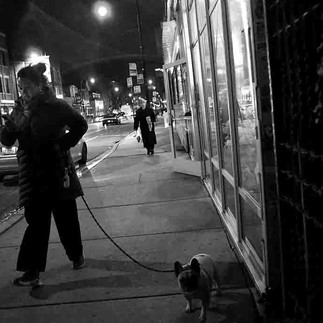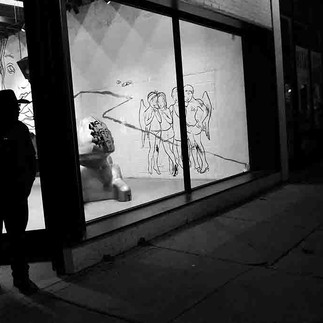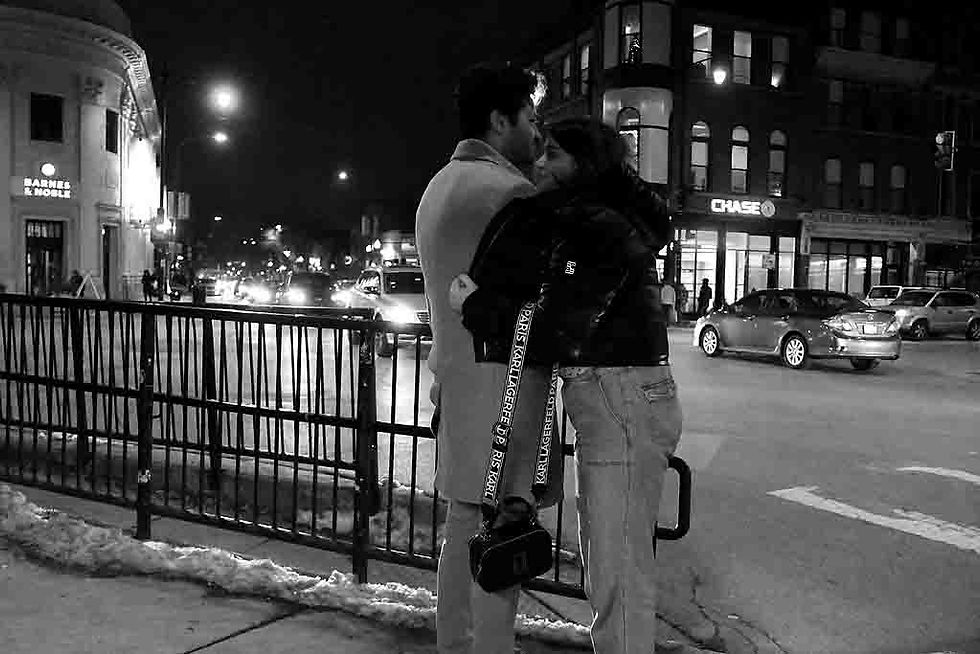Exploring the Enigmatic Night Streets of Chicago: A Glimpse into the Quiet Neighborhood Life on a Cold Evening - Today's Pictures
- Feng Liu
- Nov 21, 2024
- 6 min read
Chicago's night streets weave a tale all their own. As the sun dips below the horizon and the city’s vibrant energy hushes, local neighborhoods awaken in a quieter light. Night photography, especially in these tranquil settings, can capture the essence of urban life in ways that daylight rarely can.
On one particularly chilly evening, with temperatures dropping to around 25°F, the streets provide an intimate portrait of the city’s character. With only a handful of people braving the cold, the stage is set for an evocative exploration of Chicago’s neighborhoods after dark.
The Calm Before the Night
As night descends, the streets of Chicago transform into a canvas of shadows and soft, flickering lights. Streetlights illuminate the cold pavement, creating a warm glow that contrasts starkly with the winter chill. This unique setting highlights the local life—quiet yet brimming with subtle vibrancy.
Many photographers flock to the frenetic energy of downtown, but capturing neighborhood life during these cold evenings holds a special allure. Observing the way chilly air causes breaths to form clouds and how it influences human interactions turns an ordinary outing into a striking visual tale. For instance, you might capture an elder couple sharing a moment outside a corner store, their laughter resonating despite the bitter cold.
Embracing the Cold
On this exceptionally frigid day, temperatures have plummeted below average, and it influences both the atmosphere and the people within it. Bundled in thick winter coats, Chicagoans navigate the streets, each one contributing to the city’s larger story. The cold acts as a deterrent for many, creating rare moments of solitude that are perfect for photography.
As the camera captures these fleeting scenes, it reveals the beauty in everyday life—people waiting for the bus, two friends sharing a warm drink at a cozy café, or a solitary figure quietly walking their dog. Each photograph captures unique moments, inviting viewers to connect with the stories behind those braving the evening chill.
Observing the Neighborhood
Chicago’s neighborhoods showcase a rich tapestry of history and culture, each one boasting a distinct rhythm that feels more intimate than the pulse of downtown. The evening provides an opportunity to observe the community’s daily life, highlighting moments that daylight often overshadows.
For example, while wandering through the Logan Square neighborhood, you might come across a small art installation on a quiet street corner, showcasing local artists or a mural depicting significant cultural stories. Capturing these elements allows photographers to explore the details that are often overlooked, transforming the cold environment into a canvas of warmth and community spirit.
The Few in the Streets
Even on the coldest evenings, a few brave souls venture out. They might be jogging, walking dogs, or simply enjoying the beauty of a frostbitten landscape. Each individual adds to the overall narrative, connecting with their environment and, perhaps, each other.
When captured through photography, these moments transcend mere visuals; they reflect the bond people share with their surroundings. A photograph of a child playing with snowflakes, for instance, offers a glimpse into joy, warmth, and community, even amidst freezing temperatures.
Pairing Photography with Storytelling
Photography in the night streets of Chicago transforms into a storytelling medium. Each picture taken in the soft light tells a unique story, capturing the essence of solitude, connection, or life’s simple moments. The cold air creates stillness, while the warmth spilling from windowpanes invites viewers to imagine the lives unfolding behind those walls.
Photographers can become storytellers, illustrating how life within a neighborhood continues to thrive despite winter’s embrace. The laughter echoing through the night, the glow of candles in local cafés, and the rustle of frozen leaves create a captivating narrative.
A Night to Remember
Exploring the night streets of Chicago opens doors to remarkable opportunities for street photography and intimate storytelling. The stark beauty of the cold, paired with the few adventurers who venture out, offers a lens on local life unlike any other.
Consider each evening as a canvas, a snapshot of a neighborhood’s soul—inviting photographers and observers alike to partake in its narrative. So next time the temperature drops, bundle up, grab your camera, and take a journey through the captivating streets that only nighttime can unveil.
Judging Feng Liu's street photography—or any photographer's work—requires a combination of technical, aesthetic, and conceptual analysis. Feng Liu, known for his powerful and evocative street photography, blends various elements to create images that resonate with viewers. Here's how you might evaluate his street photography:
1. Composition
Framing and Rule of Thirds: Examine how Feng Liu frames his subjects. Does he use the rule of thirds, or does he break conventional rules for dramatic effect? In street photography, unconventional framing can often be more striking.
Lines and Geometry: Street photographers often play with the geometry of the urban environment. Look at how Liu uses architectural lines, leading lines, or symmetry to draw the viewer's attention and structure the image.
Juxtaposition: Street photography often captures contrasts—whether it's light vs. dark, old vs. new, or quiet moments amidst chaos. Does Liu effectively juxtapose elements to tell a story?
2. Lighting
Natural Light: Street photography relies heavily on available light. Pay attention to how Feng Liu uses natural lighting—whether it's harsh midday sun, the soft glow of dusk, or the interplay of shadows and highlights.
Mood and Atmosphere: Street photography often captures fleeting moments with a strong emotional charge. Consider whether Liu’s use of light and color creates a sense of mood—whether it’s melancholic, joyful, chaotic, or serene.
3. Subject Matter and Storytelling
Human Interaction: Street photography often revolves around the human element. Does Feng Liu focus on human interactions, gestures, or facial expressions? Does the photo tell a story about the subjects' emotions, relationships, or the environment they inhabit?
Candid Moments: Look for the spontaneity of his images. Great street photography often captures candid moments, unposed and full of genuine emotion. How well does Liu capture these unguarded, authentic moments?
Context and Message: Does Liu’s work communicate something beyond the immediate scene? Some street photographers address larger social issues, urban life, or culture. Look for underlying themes or commentaries about society or the human condition in his work.
4. Timing and Moment
Decisive Moment: Henri Cartier-Bresson coined the term “the decisive moment,” referring to capturing a fleeting moment that perfectly encapsulates the essence of a scene. Does Liu capture such moments—where everything aligns perfectly in terms of composition, timing, and subject matter?
Movement and Energy: Does Liu effectively capture the energy of the street? Street photography often involves motion, whether it’s a person walking, cars speeding by, or crowds moving. How does Liu convey this energy through his photos?
5. Technical Skill
Exposure and Focus: While street photography often embraces spontaneity, the technical quality of the image still matters. Look at whether the exposure is appropriate (not too dark or overexposed) and whether the focus is sharp where it needs to be. Is there any intentional blur or motion to add drama?
Depth of Field: Does Liu use a shallow depth of field to isolate the subject from the background, or does he use a larger depth of field to keep the environment in focus? How does this choice affect the overall impact of the image?
Post-Processing: Examine how Liu edits his photos. Does he favor high contrast, muted tones, or any particular style of post-processing? Subtle editing can enhance a street photograph, but overly heavy processing can detract from the authenticity of the moment.
6. Originality and Voice
Uniqueness: Does Liu bring something new or distinctive to street photography? Street photography can be an oversaturated genre, so it’s important to evaluate whether Liu has a unique voice, style, or perspective that sets him apart from other photographers.
Personal Perspective: Does his work reveal a personal vision or experience? A strong street photographer often captures the world through their own eyes—through their emotional and intellectual perspective. Is there something about Liu's work that feels deeply personal, even though it's of public spaces?
7. Engagement with the Urban Environment
Relationship with the City: Since street photography often takes place in urban environments, does Liu have an interesting take on the city itself? Is he capturing the city's soul—its rhythms, its contrasts, its quiet moments and noisy streets?
Contextual Awareness: Is there a sense of awareness of the photographer’s role in the public space? Does Liu engage with the street itself—through reflections, crowds, or urban textures—or does he mostly focus on isolated moments and individuals?
8. Impact and Emotional Resonance
Emotional Impact: Does Feng Liu’s street photography evoke an emotional response? Great street photography often creates a sense of connection to the people or the environment it depicts. Does his work make you think, feel, or see the world differently?
Timelessness: Some street photography feels timeless, capturing universal experiences. Does Liu's work feel like it could be from any era, or does it speak to a specific time and place?







































Comments